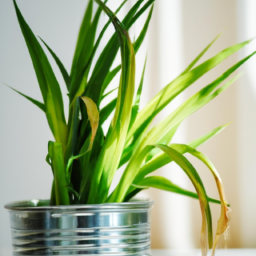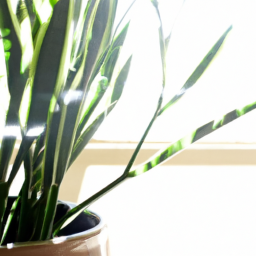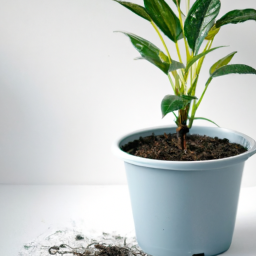
Have you ever wondered, “Can indoor plants survive without sunlight?” It’s a common question among plant enthusiasts and those who live in spaces with limited natural light. We often associate plants with being outdoors, basking in the sun’s rays, but what about those that are confined to the indoors? In this blog post, we’ll explore the fascinating world of indoor plants and discover whether they can thrive without direct sunlight. So, if you’re curious about how these green companions adapt to their light-deprived environments, keep reading to uncover the secrets behind their survival strategies.
The Importance of Sunlight for Indoor Plants’ Survival
Indoor plants are a beautiful addition to any home or office space. They not only enhance the aesthetic appeal but also provide numerous health benefits. However, one crucial factor that determines the survival and growth of indoor plants is sunlight. In this article, we will explore the significance of sunlight for indoor plants and discuss alternative options for plants that have limited access to natural light.
Why Do Indoor Plants Need Sunlight?
Sunlight is essential for indoor plants as it plays a vital role in the process of photosynthesis. Photosynthesis is the process by which plants convert sunlight into energy, enabling them to produce food for growth and survival. Sunlight provides the necessary energy for chlorophyll, a pigment present in plants, to convert carbon dioxide and water into glucose and oxygen.
In addition to photosynthesis, sunlight also helps regulate the overall health and development of indoor plants. Exposure to natural light promotes proper leaf and stem growth, strengthens the plant’s immune system, and enhances its ability to resist pests and diseases. Sunlight also aids in the production of essential vitamins and hormones that contribute to the overall well-being of the plant.
Furthermore, sunlight plays a crucial role in the circadian rhythm of plants. Just like humans, plants have an internal clock that regulates their daily activities. Sunlight helps plants synchronize their biological processes, such as opening and closing of stomata, blooming, and even the release of fragrance.
Alternative Options for Indoor Plants with Limited Sunlight
While sunlight is crucial for indoor plants, some situations may limit their access to natural light. For instance, if you have a room with minimal windows or live in a location with long periods of cloudy weather, you need to consider alternative options to ensure the survival of your indoor plants.
1. Artificial Light Sources: One effective solution is to provide artificial light sources that mimic the spectrum of natural sunlight. LED grow lights, fluorescent lights, and compact fluorescent lights (CFLs) are popular choices. These lights emit the necessary wavelengths of light that plants require for photosynthesis. Position the lights above the plants, ensuring they receive adequate light for 12-16 hours a day.
2. Reflective Surfaces: Another strategy to maximize the available sunlight is to use reflective surfaces. Placing plants near windows or using reflective materials, such as mirrors or aluminum foil, can help redirect and amplify the natural light. This technique is especially useful in rooms with limited windows.
3. Selecting Low-Light Tolerant Plants: If natural light is scarce, consider choosing indoor plants that are known to thrive in low-light conditions. Some popular options include snake plants, pothos, ZZ plants, and peace lilies. These plants have adapted to survive with minimal sunlight and can still thrive indoors.
Remember, even with alternative options, it is essential to monitor your plants closely. Observe their growth, check for any signs of stress or nutrient deficiencies, and adjust the lighting accordingly. Each plant has specific light requirements, so understanding their needs is crucial for their survival.
In Conclusion
Sunlight is vital for the survival and growth of indoor plants. It provides the energy needed for photosynthesis, regulates plant health and development, and synchronizes their biological processes. However, in situations where natural light is limited, alternative options such as artificial light sources, reflective surfaces, and low-light tolerant plants can help ensure the well-being of your indoor plants. By understanding the importance of sunlight and implementing suitable solutions, you can create a thriving indoor garden that adds beauty and freshness to your living space.

Can Indoor Plants Survive Without Sunlight?
Indoor plants are a great addition to any space, bringing life, color, and a sense of tranquility. However, not all indoor areas receive an adequate amount of sunlight to support plant growth. So, can indoor plants survive without sunlight? Let’s explore alternative light sources that can help indoor plants thrive.
1. Understanding the Importance of Light for Plants
Before delving into alternative light sources, it’s important to understand why light is crucial for plants. Light is essential for photosynthesis, a process through which plants convert light energy into chemical energy, enabling them to grow and produce food. Sunlight provides a full spectrum of light, including ultraviolet (UV) and infrared (IR) radiation, which are vital for plant development.
When plants lack sufficient light, they may exhibit signs of stress, such as stunted growth, yellowing leaves, and a weakened immune system. Without access to sunlight, indoor plants rely on alternative light sources to fulfill their light requirements.
2. Alternative Light Sources for Indoor Plants
2.1. LED Grow Lights
LED (Light Emitting Diode) grow lights have gained popularity among indoor gardeners due to their energy efficiency and ability to provide specific light wavelengths that promote plant growth. These lights emit a narrow light spectrum that can be tailored to match the needs of different plant species.
LED grow lights are available in various colors, including red, blue, and white. Red light encourages flowering and fruiting, while blue light promotes leafy growth. White light, which combines both red and blue wavelengths, provides a balanced spectrum suitable for overall plant development.
When using LED grow lights, it’s important to position them at an appropriate distance from the plants to prevent light burn. The distance may vary depending on the plant’s light requirements, so it’s recommended to refer to the manufacturer’s guidelines.
2.2. Fluorescent Lights
Fluorescent lights, particularly T5 and T8 tubes, are another popular option for indoor plant lighting. These lights emit a broader spectrum of light compared to LED grow lights, making them suitable for a wide range of plants.
T5 fluorescent lights are highly efficient and produce a high-intensity light output, making them ideal for plants with high light requirements. On the other hand, T8 fluorescent lights are more affordable and can provide sufficient light for plants with moderate light needs.
When using fluorescent lights, it’s important to position them close to the plants, typically within a few inches, to ensure they receive an adequate amount of light. Additionally, fluorescent lights should be replaced every 6-12 months to maintain their effectiveness.
2.3. High-Intensity Discharge (HID) Lights
HID lights, such as metal halide (MH) and high-pressure sodium (HPS) lights, are commonly used in commercial indoor gardening setups. These lights emit intense light, similar to sunlight, and are suitable for plants with high light requirements or during the flowering stage.
MH lights emit a bluish-white light, which promotes vegetative growth, while HPS lights emit a reddish-orange light, ideal for flowering and fruiting. Some indoor gardeners use a combination of MH and HPS lights to provide a balanced light spectrum throughout the plant’s growth cycle.
However, HID lights generate a significant amount of heat and require proper ventilation and cooling systems to prevent damage to the plants. They also consume more energy compared to LED and fluorescent lights.
3. Supplementing Natural Light with Artificial Light
While alternative light sources can help indoor plants survive without direct sunlight, it’s still beneficial to provide them with some natural light whenever possible. Placing plants near windows or using reflective surfaces to redirect sunlight can enhance their growth.
When supplementing natural light with artificial light, it’s important to ensure a consistent light cycle for the plants. Most plants require around 12-16 hours of light per day for optimal growth. Using a timer can help automate the lighting schedule and ensure the plants receive the necessary amount of light.
Conclusion
Indoor plants can indeed survive without sunlight by utilizing alternative light sources. LED grow lights, fluorescent lights, and HID lights are effective options for providing the necessary light spectrum for plant growth. By understanding the importance of light for plants and supplementing natural light with artificial light, you can create a thriving indoor garden that brings beauty and vitality to your space.

Low-Light Indoor Plants: Thriving in Sunlight-Deficient Environments
Indoor plants are a wonderful addition to any home or office space. They not only add a touch of nature and beauty to our surroundings but also provide numerous health benefits. However, not all indoor environments are blessed with ample sunlight. So, can indoor plants survive without sunlight? Let’s explore this topic and discover some low-light indoor plants that can thrive in sunlight-deficient environments.
Understanding the Importance of Sunlight for Plants
Sunlight is crucial for plants as it serves as their primary source of energy through a process called photosynthesis. During photosynthesis, plants convert sunlight into chemical energy, which is then used to fuel their growth and development. Sunlight also helps in the production of chlorophyll, the green pigment responsible for capturing light energy.
While most plants require a certain amount of direct or indirect sunlight to thrive, there are some species that have adapted to low-light conditions. These plants have evolved various mechanisms to maximize their ability to capture and utilize available light, making them suitable for indoor environments with limited sunlight.
Now, let’s delve into some low-light indoor plants that can flourish even in sunlight-deficient environments:
1. Snake Plant (Sansevieria trifasciata)
The Snake Plant, also known as Mother-in-Law’s Tongue, is a popular choice for low-light indoor spaces. It is a hardy plant that can tolerate a wide range of light conditions, including low light. The Snake Plant has long, upright leaves that are typically green with yellow edges, although there are also varieties with darker green leaves. It is an excellent air purifier, removing toxins from the air and improving indoor air quality.
2. ZZ Plant (Zamioculcas zamiifolia)
The ZZ Plant is another low-maintenance indoor plant that thrives in low-light conditions. It has glossy, dark green leaves that grow in a graceful, arching manner. The ZZ Plant is known for its ability to tolerate neglect and can go for long periods without water. It is a great choice for beginners or those who often forget to water their plants.
3. Pothos (Epipremnum aureum)
Pothos, also known as Devil’s Ivy, is a versatile indoor plant that can adapt to a wide range of light conditions. It can survive in low light but thrives in bright, indirect light. Pothos has heart-shaped leaves that come in various shades of green, and some varieties have variegated foliage with splashes of yellow or white. It is an excellent trailing plant that can be grown in hanging baskets or allowed to climb up a trellis.
Benefits of Low-Light Indoor Plants
Low-light indoor plants not only survive but also offer several benefits for indoor spaces:
1. Improved Air Quality: Many low-light indoor plants, such as Snake Plant and Pothos, are known for their air-purifying properties. They can remove harmful toxins like formaldehyde, benzene, and xylene from the air, creating a healthier indoor environment.
2. Stress Reduction: Indoor plants have been shown to reduce stress and promote a sense of well-being. The presence of greenery indoors can create a calming and soothing atmosphere, helping to improve mood and productivity.
3. Natural Décor: Low-light indoor plants add a touch of nature and beauty to any space. They can enhance the aesthetics of a room, making it more inviting and visually appealing.
Conclusion
While sunlight is essential for most plants, there are several low-light indoor plants that can thrive in sunlight-deficient environments. The Snake Plant, ZZ Plant, and Pothos are just a few examples of low-light plants that can add life and beauty to your indoor spaces. These plants not only survive but also offer numerous benefits, including improved air quality and stress reduction. So, even if your indoor space lacks natural sunlight, you can still enjoy the beauty and benefits of indoor plants.
Essential Points
Indoor plants have become increasingly popular, adding a touch of nature and beauty to our living spaces. However, many people wonder if these plants can thrive without direct sunlight. The good news is that yes, indoor plants can survive without sunlight, but they do need some form of light to grow and stay healthy.
While sunlight is the best source of light for plants, there are alternatives that can support their growth. One option is to place your indoor plants near a window where they can receive indirect sunlight. This means that the light is filtered through a curtain or a sheer fabric, providing a softer and less intense light for the plants. Another alternative is to use artificial lights, such as fluorescent or LED grow lights, which can mimic the spectrum of natural sunlight. These lights should be placed close to the plants and turned on for about 12-16 hours a day to ensure they receive enough light energy for photosynthesis.
It’s important to note that different plants have different light requirements, so it’s essential to choose the right plants for your indoor space. Some plants, like snake plants or ZZ plants, are known for their ability to tolerate low light conditions and can survive in areas with minimal sunlight. On the other hand, plants like succulents or flowering plants typically require more direct sunlight to thrive. By understanding the light needs of your indoor plants and providing them with the appropriate light source, you can create a thriving indoor garden even without direct sunlight.
FAQ Roundup:
Q1: Can indoor plants survive without sunlight?
A1: Yes, some indoor plants can survive without direct sunlight. While most plants need sunlight to carry out photosynthesis, there are several varieties that can thrive in low-light conditions. These plants have adapted to survive in the understory of forests where they receive filtered or indirect sunlight.
Q2: What are some indoor plants that can survive without sunlight?
A2: There are several indoor plants that can thrive in low-light environments. Some popular options include the snake plant (Sansevieria), ZZ plant (Zamioculcas zamiifolia), pothos (Epipremnum aureum), peace lily (Spathiphyllum), and cast iron plant (Aspidistra elatior). These plants have evolved to efficiently use available light and can tolerate lower light conditions.
Q3: How can indoor plants survive without sunlight?
A3: Indoor plants that can survive without direct sunlight have adapted various strategies to make the most of available light. They have larger leaves to capture more light, can efficiently convert light energy into chemical energy, and often have chloroplasts located deeper within their leaves. Additionally, some plants can store energy and nutrients to sustain themselves during periods of low light.
Q4: How should I care for indoor plants that don’t require sunlight?
A4: While these plants can survive in low-light conditions, it’s important to provide them with suitable care. Place them in areas with bright, indirect light, such as near north-facing windows or a few feet away from east or west-facing windows. Avoid exposing them to direct sunlight as it can damage their leaves. Additionally, ensure the soil is well-drained and water the plants when the top inch of soil feels dry. Regularly dust the leaves to allow maximum light absorption.
Q5: Can artificial light be used to substitute sunlight for indoor plants?
A5: Absolutely! If you have indoor plants that require more light than your space can provide naturally, you can use artificial light sources to supplement or substitute sunlight. LED grow lights or fluorescent lights specifically designed for plants can be used to provide the necessary light spectrum and intensity. Place the lights a few inches above the plants and keep them on for about 12-16 hours a day to mimic natural daylight.

James Wong is a renowned ethnobotanist, plant scientist, and local television presenter. With a passion for demystifying plant science, he is known for translating complex botanical concepts into practical advice for everyday plant enthusiasts. James’s expertise spans from traditional gardening to cutting-edge plant technologies, making his insights accessible and informative.


